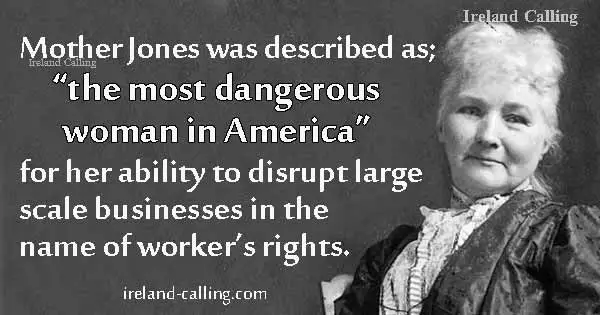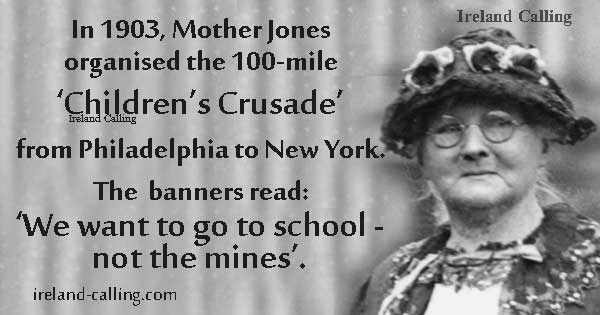Mother Jones was born in 1837 in Cork. The exact date of her birth is unknown. She moved to Canada as a teenager and then on to America where she began working as a teacher.

Jones got married and started a family. She also opened a dressmaking shop which she ran after giving up her job as a teacher. Two terrible events then changed her life forever. First, her husband and four children (all under the age of five) died from yellow fever during the epidemic in Tennessee in 1867. Jones moved to Chicago to try and rebuild her life and opened a new dressmaking shop. Unfortunately, that burnt down in the Great Chicago Fire on 1871, leaving her without a home and source of income.
Campaigner for workers’ rights
Jones turned her attention to campaigning for workers, who were being downtrodden and exploited by their employers. She was a key organiser in the United Mine Workers, leading several marches and picketing campaigns. She also urged the strikers not to return to work when they faced intimidation from strike-breakers hired by their employers. Fundamental to her beliefs was that working men should be able to earn enough money from a hard day’s work to provide for their families, so that the women were able to look after the house and the children.
Described as ‘the most dangerous woman in America’
During the height of these labour movements, Jones was described as “the most dangerous woman in America” for her ability to disrupt large scale businesses in the name of worker’s rights.
At a court hearing against Jones, for ignoring an injunction banning meetings by striking miners, the prosecution lawyer Reese Blizzard said: ‘There sits the most dangerous woman in America. She comes into a state where peace and prosperity reign, crooks her finger and twenty thousand contented men lay down their tools and walk out.’
Jones had little interest in entering into the world of politics. She felt a woman’s place was in the home, and blamed increasing levels of juvenile delinquency on the rise of women going out to work. However, she knew that despite not being directly involved in politics, she could make a difference. She was once quoted as saying: “You don’t need the vote to raise hell!” She did encourage the wives of workers to play their part though, by picketing and acting as both motivator and support to their husbands in the struggles.
Mother Jones organised the ‘Children’s Crusade’
She began to become known as ‘Mother Jones’, because of her maternal instincts to protect, and she also always referred to the miners and factory workers as ‘her boys’.
In 1903, Jones organised the ‘Children’s Crusade’, the movement she is probably best remembered for. She wanted to bring an end to child labour, and organised a march of thousands of child workers from Philadelphia to the hometown of President Roosevelt in New York. The children marched with banners that read ‘We want to go to school and not the mines’. Jones led the march of nearly 100 miles, despite being in her sixties at the time.

Jones continued to campaign for the rights of children and workers and was even sentenced to time in prison for her actions. She eventually gained enough notoriety that she was met by oil magnate John D. Rockefeller Jr. After their discussion, Rockefeller agreed to investigate the conditions of the mines, and put in place some long term reforms to his own company’s policy.
Jones organised and campaigned right up until her death in 1930, aged 93. She left a legacy that has not been forgotten. The 1970s magazine Mother Jones was named in her honour.
Click here to read about more great characters from Irish history
history.html